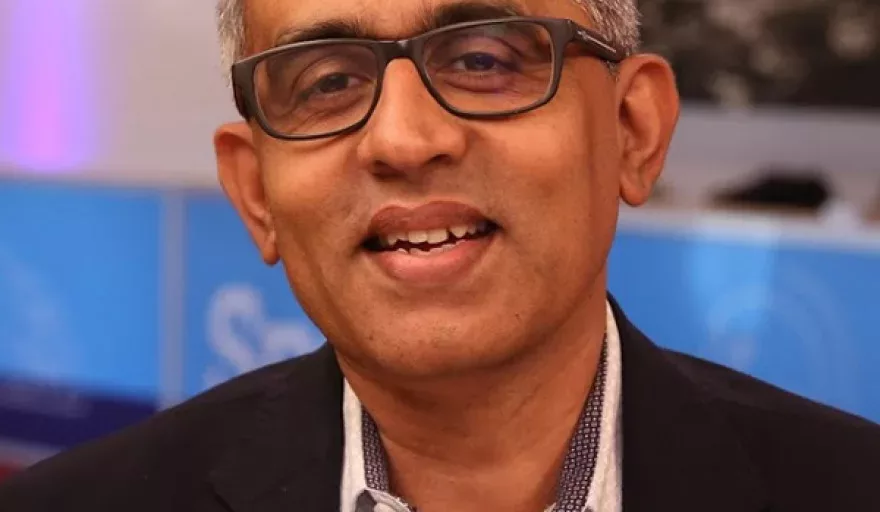$170.8 billion in annual revenue, 273,000 employees, 150,000 network subscribers. The world’s largest telecommunications company, it’s hard to comprehend the stature of AT&T – a headache that even its own staff have to deal with.
“It’s such an overwhelmingly large corporation, it’s easy to see how it can be intimidating,” Vishy Gopalakrishnan states.
First becoming acquainted with AT&T in 2008, a brief hiatus at SAP separating two stints at the business, Gopalakrishnan has worked across multiple segments, from product marketing to corporate strategy and now as the Vice President of Ecosystem and Innovation.
“What does this role actually entail? It sounds about as corporate as you can imagine,” he continues. “Effectively, the question myself and my team are looking at is how a company like AT&T subjectively evaluates both internal and external innovation to incorporate new principles, products and services.
“That’s ultimately our genesis, it’s what we’re here to do.”
More specifically, the company has broken this down into three innovation highways, with the Ecosystem and Innovation team acting as the eyes and ears of the business on this front, implementing fresh, unorthodox, unconventional ideas.
“We meet with a roughly 500 startups every year, spanning all segments from networking to security to advertising technologies and everything in between,” Gopalakrishnan reveals. “Alongside this we have the Foundry, a series of innovation centres, four in the US, one in Tel Aviv, Israel and another in Mexico City.
“Often, we’ll be presented with a concept that shows a lot of promise but might just be words on a slide. The Foundry then comes in with its team of engineers, running prototypes to essentially de-risk and prove or disprove these ideas, putting the technologies through their paces.”
Not only does the Foundry aid startups, but equally it is one of the company’s most esteemed tools when working with businesses to overcome problems. To this end, AT&T ensures that it remains on top of cutting-edge academic research, consuming this and transferring the knowledge into algorithms that can be used to the benefit of enterprises.
“The third element of Ecosystem and Innovation,” Gopalakrishnan continues, “is an internal initiative named TIP, or the innovation platform, that’s effectively a kick-starter for employee innovation.
“Any employee can submit his or her idea to a completely democratic, grassroots portal that is then transparently ranked by rating, much like TripAdvisor.”
At the end of each quarter, the top four highest rated ideas are then presented to the company’s internal angel investor team that is made up of senior executives, providing the best ideas with funding, while the Foundry helps to prototype these ideas and eventually even bring them to market.
“We’re agnostic about where innovation comes from,” adds Gopalakrishnan. “It’s an art and a science, and I like to say that the book is not written but we’re always adding new chapters.”
Identification and application
Leveraging this broad, three-pronged scope, AT&T is able to call upon a diverse range of innovative successes across all sectors, one specific example being the firm’s recent work with temperature control packaging systems specialist Softbox.
An award winning, transformative business in the cold chain sphere, AT&T worked closely with the UK-based organisation in the latter stages of 2019, helping implement its expertise more extensively in the healthcare market.
“Let’s say a pharmaceutical company is sending me some very high-value medication,” Gopalakrishnan explains. “Maybe it’s part of a clinical trial, so they want to make sure that I’m taking it regimentally, that it’s kept at the right temperatures, etc.
“Softbox were already making packaging that has been able to keep medication at a particular temperature, but they wanted to expand the capabilities of their product. This in mind, we helped them build in sensors that would monitor when its packaging was opened, when medication was removed, whether it was kept at the right temperature, and even provide an idea of the location.”
Integrating connectivity technologies, the pair then went further, exploring a proof of concept study to use drones to transport these medicinal parcels, enabling scarce, lifechanging health resources to travel to remote locations, including areas hit by natural disasters.
Active in the smart healthcare sphere in other ways, AT&T further collaborated with US orthotics and prosthetics manufacturing firm Hanger late last year.
Implementing a gyroscope, magnetometer and accelerometer into Hanger’s modules, the Houston-based Foundry was effectively able to help reduce the severe discomfort suffered by patients during the first few weeks when using below the knee prosthetics.
“What these do is measure how much you walk, the type of walking such as going up and down stairs, and your direction and tilt,” reveals Gopalakrishnan.
“With this we went from zero visibility into what’s going on with the prosthetic, to real-time visibility with what’s happening with the patient, allowing adjustments to be made and advice to be offered, tremendously improving the quality of care.”
Realising the time and wrapping up the conversation, we shook hands and headed back out to the main floor of AT&T’s booth, as Gopalakrishnan left us with some final thoughts.
He concludes: “To succeed in this business you have to remain unconstrained. Every company is a technology company… every industry has the potential to be disrupted… and a critical part of this is engaging with startups.
“Our focus is not on the paperwork but on the collaboration.”


































